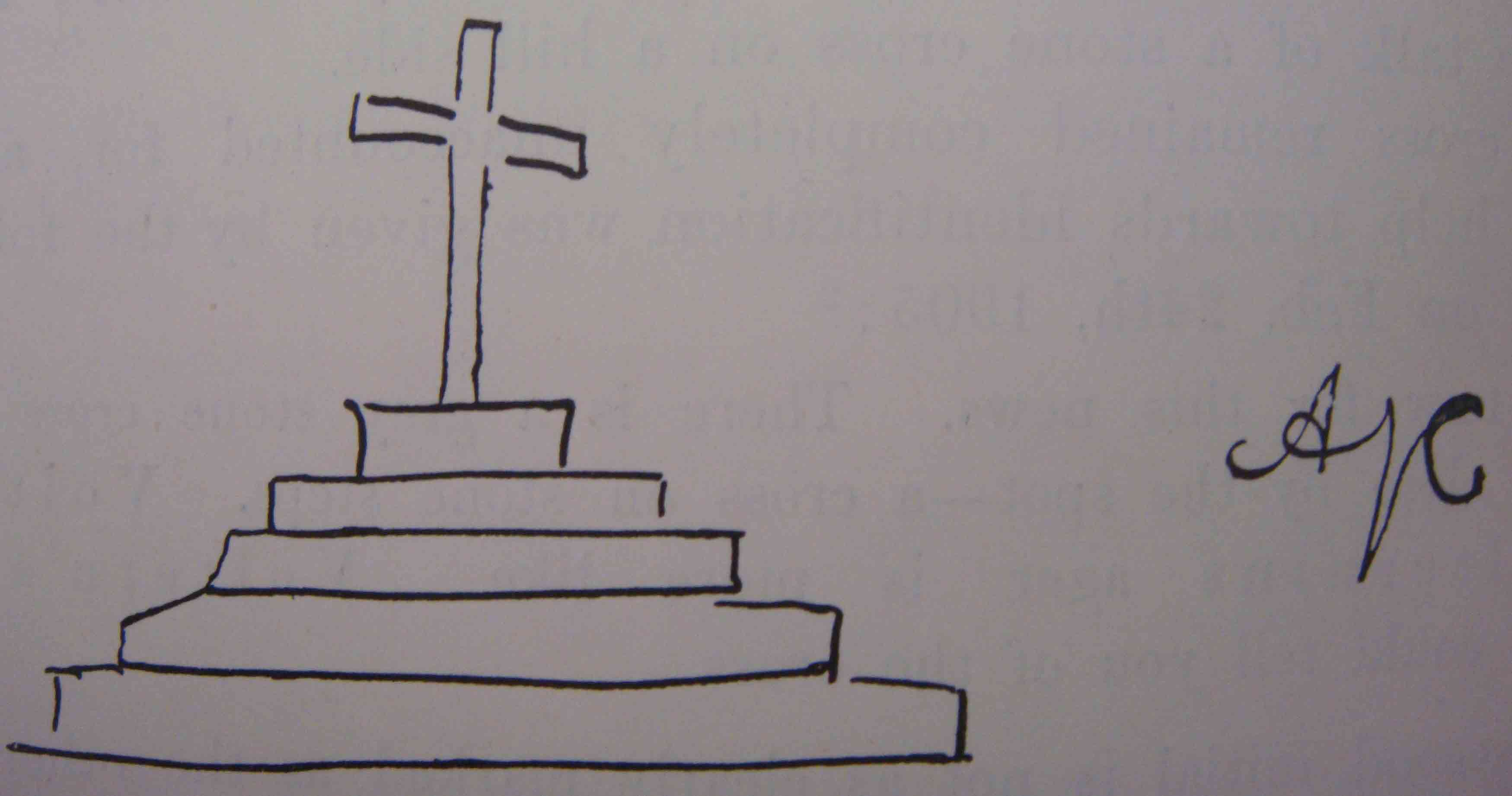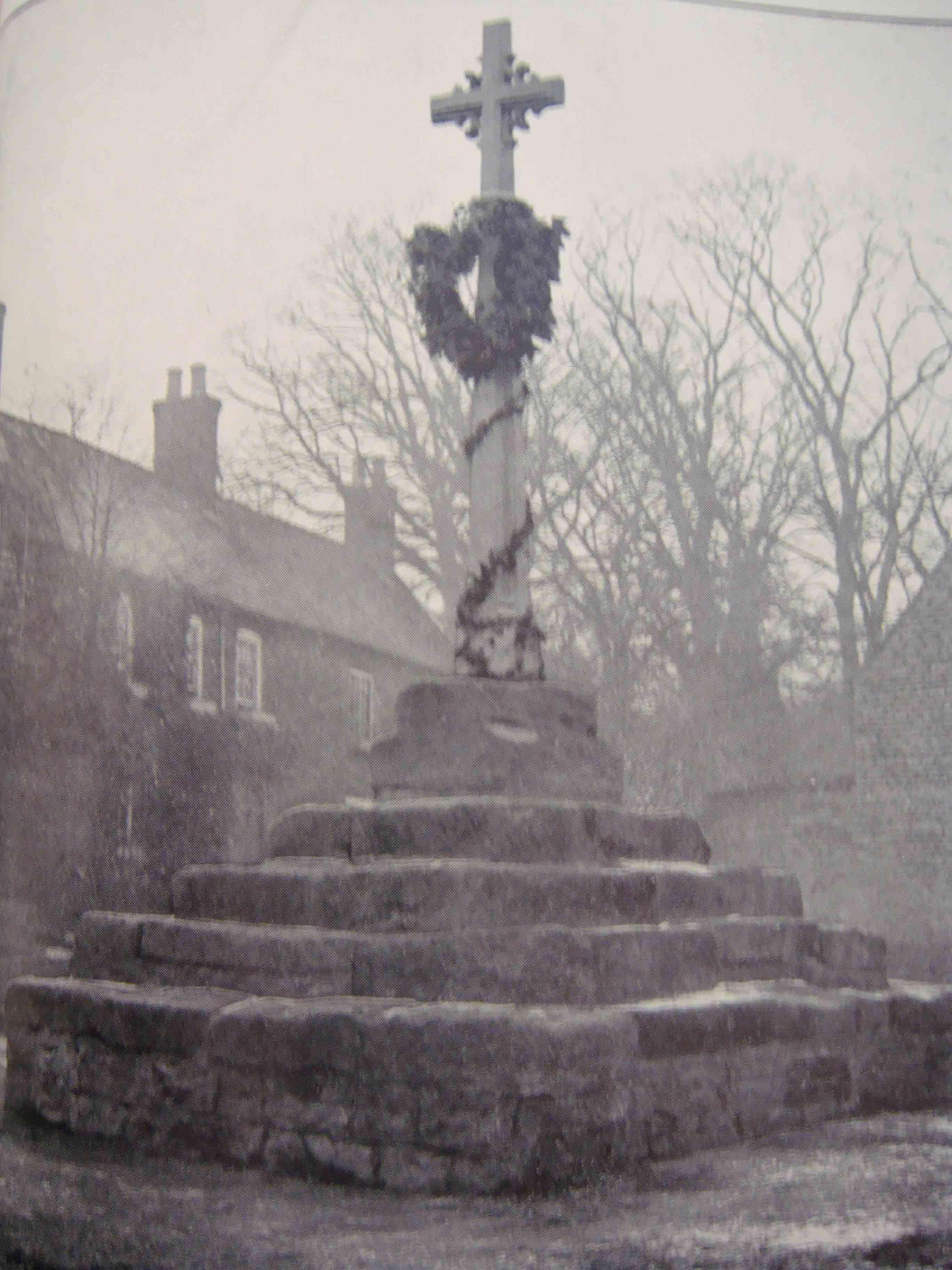(15) On April 2nd, 1903, the script described a cross on stone steps in the following words:
Now draw on five stone steps a cross [drawing] and on the cross hangs a wreath, a fresh green wreath. They have come to see it there - out in the open on the hill side in the sound of the sea. It is not a personal thing - but know(n). This is for evidence. There is an inscription fastened to the wreath. In honour A. J. C.1 In ripis Douern I think it is for an old heroic deed. Grey sky and sea and the grey gulls cry in the wind. Kyrie eleeison.
A few days later, April 10th, 1903, it added:
Crosik or Croisic ought to help you to the cross and wreath.
In the Journal for November, 1903, among other unidentified allusions, I advertised the names Douern and Croisic in connexion with a cross, but I received no information leading to any identification. Croisic is, as I knew, in Brittany, and the allusion to it may have been suggested by the word Douern and the talk of a stone cross on a hill side. The cross remained completely unaccounted for, and no further help towards identification was given by the following allusion on Feb. 24th, 1905:2
Wait now for this news. There is a grey stone cross on the hill side close by the spot - a cross on stone steps. Voltigern no Voltigernus ager is more like. Voltern's field. Someone could tell you of the cross.
On March 17th, 1906, a river in Yorkshire was mentioned in my presence as the Derwent. The name "Derwent" had always been vaguely suggested to me by the "Dovinians" of the early script, 3and the "Douern" of April 3rd, 1903, had seemed a possible variant. The mention, then, of the Yorkshire Derwent probably revived recollections of earlier script, and at 11.30 p.m. that evening was produced another reference to the cross, this time apparently suggesting that I should have an opportunity of seeing an recognising the cross on its five steps, and the green wreath:
Stone I want to say. Stone a white stone and no inscription but you would recognise if you saw. Can you not find the cross on its five steps and the green wreath?
Domus resonantis Albunae* where flows the stream o'er Dufa's cliff, the Derwent's wandering course. On the banks of the stream - the Derwent water, not a lake - wait and see yourself what I mean.
This revived my interest in the original unidentified cross on five stone steps, and led me to look out for any possible means of verifying the statements of the script. The description has always puzzled me as it seems to imply two inconsistent things, (a) an old heroic deed and (b) a modern memorial, suggested by the fresh green wreath and the initials A. J. C. The second of these inititals, as I noted at the time, was by no means as distinct as the first and third. Facsimiles are given below of the cross drawn in the script and the initials:

On April 4th, 1906, I went by arrangement to sit with a little group of experimenters who were meeting at the rooms of Miss Curtois in Westminster. I had made Miss Curtois' acquaintance in the autumn of 1905, and visited her for the first time on December 11th, 1905. I had tea with her on that day, but I have no recollection of looking at anything in her room and certainly made no examination of her books or pictures. It was a very foggy day and we were busy talking.
On my second visit, however, on April 4th, before the arrival of the other sitters, Miss Curtois and I had some talk about books, and in doing so I looked over her book-shelves. I then saw hanging on the wall a photograph of a cross on stone steps which reminded me at once of the cross described in the script. I asked her what it was and she told me that it was a cross set up by herself in memory of her mother. I then asked Mrs Curtois' initials and found that they were A. H. C. The cross had been erected from the design of Mr. Jessopp. I next asked Miss Curtois whether there had not at some time been a green wreath on the cross - there was none in the photograph at which I was looking - and she, with some surprise, replied in the affirmative and added that there had been some discussion about a green wreath which was at one time placed on the cross. I subsequently obtained from her the following information and a photograph (here reproduced) of the cross with the green wreath attached.

In the churchyard of Washingborough, a village near Lincoln, on the river Witham, was an old pedestal of five stone steps. On this peedestal a modern cross was erected from the designs of Mr. Jessopp in memory of Mrs. Curtois, and dedicated on July 5th, 1903. There is no inscription on cross or pedestal. There is a tablet in the village church commoemorating the erection as follows: "In loving memory of Ann Henrietta, widow of the Rev. Atwill Curtois....this tablet has been erected and the village cross replaced by her daughter Margaret Anne Curtois, 1903." A green wreath was once placed on the cross, most probably at Christmas, 1903. Miss Curtois writes in April, 1906: "There was a great deal of discussion about the wreath as it was feared that it might injure the cross, and the experiment was not repeated."
The village of Washingborough lies on a little hill near the top of which stands the cross. Miss Curtois writes that she has seen the country beneath it flooded and dotted with sea-gulls, but the sea is some thirty miles away.
It thus appears that the a few days after the reference in my script (March 17th, 1906) suggesting that I should have an opportunity of seeing and recognising the cross which had been described first on April 2nd, 1903, I did see and recognise such a cross and the initials of the person in whose honour it was erected were very like those given in the script. The suggestion in the script of ancient and modern associations also corresponds with the facts. It is correct to say - or rather there was one occassion when at least when it might have been said with truth: "on the cross hangs a fresh green wreath," and "they have come to see it there out in the open on the hill side," but not "in the sound of the sea." It is also true that there is "no inscription". In the first script it was said that there was an inscription fastened to the wreath; in the last script, "a white stone and no inscription." Miss Curtois does not know whether any inscription was attached to the wreath but, as stated above, there is no inscription on cross or pedestal.
No explanation has been found to account for the names associated in the scipt with the cross: Douern, Croisic, Volternius or Voltigern. The seems no connexion between them and Washingborough or the Witham. But the general resemblance between the description in the script and the cross erected by Miss Curtois, and the near approach to correctness in the initials given in the script, seem tomake the incident worth relating. It should be said that a photograph on the cross with the wreath on it hangs in another part of Miss Curtois' room, so that it is possible that saw this picture in December, 1905, and that a recollection of it produced the script of March 17th, 1906. But when that script was produced I had no expectation of visiting Miss Curtois' house. Her letter asking me to do so was written on March 23rd and was received by me on March 24th.
In any case the original description of the cross and wreath preceded the dedication of the cross by three months and the hanging of the wreath by a still longer period, probably nine months.
1The second initial is not as clearly marked as the others. See facsimile on next page.
2The script of Feb., 1905, and March, 1906, falls outside the period dealt with in this paper, but is here included as it refers to the same subject as the earlier script of April, 1903.
*Trans. "home of the echoing Sybil." Horace (Od. I. 7. 12) so describes Tibur.